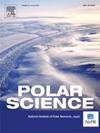Development of long-term monitoring of Antarctic moss banks to recent climate changes
IF 1.5
4区 地球科学
Q3 ECOLOGY
引用次数: 0
Abstract
The parameters of four moss banks in Argentine Islands were studied. Using unmanned aerial vehicle, we distinguished green and non-green color classes of moss in order to evaluate interannual changes. Spectral reflectance data were recorded and the normalized difference vegetation index (NDVI) values were calculated for each color class. Interannually, NDVI of green class cover increased, indicating a possible positive impact of integrate environmental factors. Laboratory measurements revealed a significant difference in chlorophyll content and shape of spectral reflectance curves (380–790 nm) for color classes of two dominant species of the moss communities, Polytrichum strictum and Sanionia georgicouncinata. The analysis of spectral indices revealed color-dependent differences in NDVI and other indices; photochemical reflectance index and NDVI were discovered to be the most sensitive to detect color classes. Chlorophyll fluorescence transients (OJIPs) and OJIP-derived parameters decreased in both species from green to non-green class due to the progressive decline in chlorophyll content and its ability to perform Photosystem II related photosynthetic processes. Thus, the green color class is healthy with a high chlorophyll content while the non-green is unhealthy, that can be used as an indicator of changes in the state of moss bank for the long-term monitoring.
南极苔藓库对近期气候变化的长期监测进展
对阿根廷群岛4个苔藓群落的参数进行了研究。利用无人机对苔藓的绿色和非绿色进行分类,评价苔藓的年际变化。记录光谱反射率数据,并计算各色类的归一化植被指数(NDVI)值。绿色覆盖NDVI年际呈增加趋势,表明综合环境因子可能对其产生积极影响。室内测量结果显示,两种优势种藓类的叶绿素含量和光谱反射曲线形状(380 ~ 790 nm)在色级上存在显著差异。光谱指数分析显示NDVI和其他指数的颜色依赖性差异;光化学反射指数和NDVI对颜色分类最敏感。叶绿素荧光瞬态(OJIPs)和OJIPs衍生的参数在这两个物种中从绿色到非绿色都有所下降,这是由于叶绿素含量及其进行光系统II相关光合过程的能力逐渐下降。因此,绿色类是健康的,叶绿素含量高,而非绿色类是不健康的,可以作为苔藓库状态变化的指标,进行长期监测。
本文章由计算机程序翻译,如有差异,请以英文原文为准。
求助全文
约1分钟内获得全文
求助全文
来源期刊

Polar Science
ECOLOGY-GEOSCIENCES, MULTIDISCIPLINARY
CiteScore
3.90
自引率
5.60%
发文量
46
期刊介绍:
Polar Science is an international, peer-reviewed quarterly journal. It is dedicated to publishing original research articles for sciences relating to the polar regions of the Earth and other planets. Polar Science aims to cover 15 disciplines which are listed below; they cover most aspects of physical sciences, geosciences and life sciences, together with engineering and social sciences. Articles should attract the interest of broad polar science communities, and not be limited to the interests of those who work under specific research subjects. Polar Science also has an Open Archive whereby published articles are made freely available from ScienceDirect after an embargo period of 24 months from the date of publication.
- Space and upper atmosphere physics
- Atmospheric science/climatology
- Glaciology
- Oceanography/sea ice studies
- Geology/petrology
- Solid earth geophysics/seismology
- Marine Earth science
- Geomorphology/Cenozoic-Quaternary geology
- Meteoritics
- Terrestrial biology
- Marine biology
- Animal ecology
- Environment
- Polar Engineering
- Humanities and social sciences.
 求助内容:
求助内容: 应助结果提醒方式:
应助结果提醒方式:


